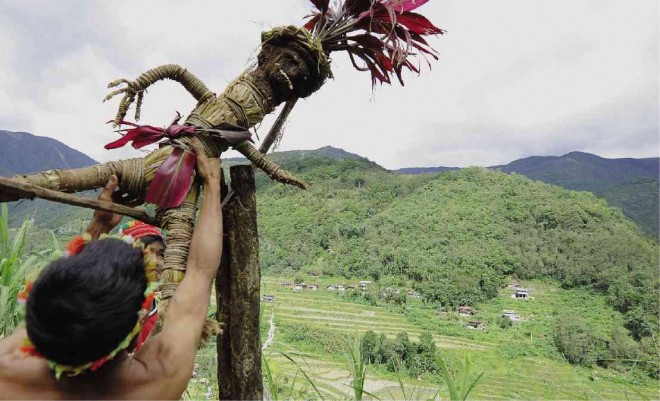
IFUGAO farmers, who tend to the iconic rice terraces, stage a ritual called “Ponnok” in Barangay Hapao, Hungduan town in Ifugao to express their gratitude to the ancestors for a bountiful harvest. Their terrace paddies stand in full view of their “muyong,” the communal forest which serves as the rice terraces’ watershed, and source of their daily requirements such as firewood.
EV ESPIRITU/INQUIRER NORTHERN LUZON
LAGAWE, Ifugao—Senator Loren Legarda on Thursday said she was baffled by the absence of a protected area coverage for the forests of Ifugao, most of which are watersheds of the world-renowned terraces.
Legarda raised the issue with Cordillera environment officials and local leaders who attended a hearing of the Senate committees on climate change and on cultural communities, which she chairs, at the provincial board session hall here.
Legarda said while there are at least 100 areas that are waiting to be enlisted as protected sites, none of these are in Ifugao.
“I am wondering why we have not thought of including the watershed forests of the Ifugao terraces to be covered by the Nipas Act, considering their role in the preservation of these very important heritage sites,” she said.
Republic Act No. 7586, or the National Integrated Protected Areas System (Nipas) Act of 1992, identifies portions of land and water that the state seeks to manage to enhance biological diversity and protect against destructive human exploration.
Legarda, who was here as guest during the province’s 49th founding anniversary on Thursday, said she met with local officials and residents to gather data on the threats of climate change to their communities, especially the Ifugao terraces.
“We know very well that the importance of the terraces is not only cultural and aesthetic,” she said.
“No less than the Food and Agriculture Organization (FAO) has declared these as globally important agricultural heritage sites,” she added.
The Senate committees on climate change and on cultural communities, she said, are looking into the possibility of including the Ifugao terraces in a second batch of sites to be covered by an expanded Nipas law, which is being crafted by Congress.
Communities to be covered by the protected status are to be consulted, she said.
“If they will agree to it, then we will push it forward. If not, then that [decision] would have to be respected,” Legarda said.
But while no law had been enacted declaring the Ifugao forests as protected areas, the people of Ifugao have, for centuries, managed to safeguard the watersheds through a traditional “muyong” system, said Mary Baguilat, acting provincial environment officer.
Through this system, Baguilat said, Ifugaos have maintained ecological balance within the terraces without government intervention, as the practice is highly respected and recognized by the Ifugao people.
“Muyong” are parcels of forest land located above the terraces, which, for generations, have been preserved and protected as the Ifugao’s primary source of wood, construction materials, food and medicine.
Environment officials, however, welcomed Legarda’s proposal, saying the funding component of the law would help augment the department’s budget for hiring forest rangers.